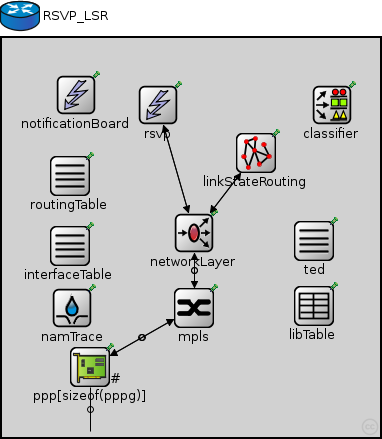 This documentation is released under the Creative Commons license
This documentation is released under the Creative Commons licenseAn RSVP-TE capable router.
RSVP occupies the Transport layer; however, it is not a transport protocol itself. RSVP uses transport protocols to route packets. TED is used to calculate shortest paths.

The following diagram shows usage relationships between types. Unresolved types are missing from the diagram. Click here to see the full picture.

The following diagram shows inheritance relationships for this type. Unresolved types are missing from the diagram. Click here to see the full picture.

| R37 (network) | (no description) |
| R37orig (network) | (no description) |
| RSVPTE4 (network) |
Example network to demonstrate RSVP-TE. |
| RSVPTE4 (network) |
Example network to demonstrate RSVP-TE. |
| RSVPTE4 (network) |
Example network to demonstrate RSVP-TE. |
| RSVPTE4 (network) |
Example network to demonstrate RSVP-TE. |
| RSVPTE4 (network) |
Example network to demonstrate RSVP-TE. |
| Name | Type | Default value | Description |
|---|---|---|---|
| namid | int | -1 | |
| peers | string | ||
| routerId | string | "auto" | |
| routingFile | string | "" |
| Name | Value | Description |
|---|---|---|
| node | ||
| labels | node | |
| display | i=abstract/router |
| Name | Direction | Size | Description |
|---|---|---|---|
| pppg [ ] | inout |
| Name | Type | Default value | Description |
|---|---|---|---|
| rsvp.traffic | xml |
specifies paths to set up |
|
| rsvp.helloInterval | double | ||
| rsvp.helloTimeout | double | ||
| classifier.conf | xml | ||
| networkLayer.ip.procDelay | double | 0s | |
| networkLayer.arp.retryTimeout | double | 1s |
number seconds ARP waits between retries to resolve an IP address |
| networkLayer.arp.retryCount | int | 3 |
number of times ARP will attempt to resolve an IP address |
| networkLayer.arp.cacheTimeout | double | 120s |
number seconds unused entries in the cache will time out |
| ppp.ppp.mtu | int | 4470 | |
| libTable.conf | xml |
table contents to be loaded on startup |
// // An \RSVP-TE capable router. // // \RSVP occupies the Transport layer; however, it is not a transport protocol // itself. \RSVP uses transport protocols to route packets. TED is used // to calculate shortest paths. // module RSVP_LSR { parameters: @node(); @labels(node,mpls-node); @display("i=abstract/router"); int namid = default(-1); string peers; string routerId = default("auto"); string routingFile = default(""); gates: inout pppg[] @labels(PPPFrame-conn); submodules: notificationBoard: NotificationBoard { parameters: @display("p=74,57"); } routingTable: RoutingTable { parameters: IPForward = true; routerId = routerId; routingFile = routingFile; @display("p=68,138"); } interfaceTable: InterfaceTable { parameters: @display("p=68,208"); } ted: TED { parameters: @display("p=312,203"); } linkStateRouting: LinkStateRouting { parameters: peers = peers; @display("p=254,115"); } rsvp: RSVP { parameters: peers = peers; @display("p=156,67"); } classifier: SimpleClassifier { parameters: @display("p=330,67"); } networkLayer: NetworkLayer { parameters: @display("p=192,195"); gates: ifIn[sizeof(pppg)]; ifOut[sizeof(pppg)]; } ppp[sizeof(pppg)]: PPPInterface { parameters: @display("p=88,329,row,90;q=l2queue"); } mpls: MPLS { parameters: classifier = "classifier"; @display("p=192,270"); gates: netwIn[sizeof(pppg)]; netwOut[sizeof(pppg)]; ifIn[sizeof(pppg)]; ifOut[sizeof(pppg)]; } libTable: LIBTable { parameters: @display("p=312,268"); } namTrace: NAMTraceWriter { parameters: namid = namid; @display("p=70,270"); } connections allowunconnected: linkStateRouting.ipOut --> networkLayer.ospfIn; linkStateRouting.ipIn <-- networkLayer.ospfOut; rsvp.ipOut --> networkLayer.rsvpIn; rsvp.ipIn <-- networkLayer.rsvpOut; for i=0..sizeof(pppg)-1 { pppg[i] <--> ppp[i].phys; ppp[i].netwOut --> mpls.ifIn[i]; ppp[i].netwIn <-- mpls.ifOut[i]; mpls.netwOut[i] --> networkLayer.ifIn[i]; mpls.netwIn[i] <-- networkLayer.ifOut[i]; } }